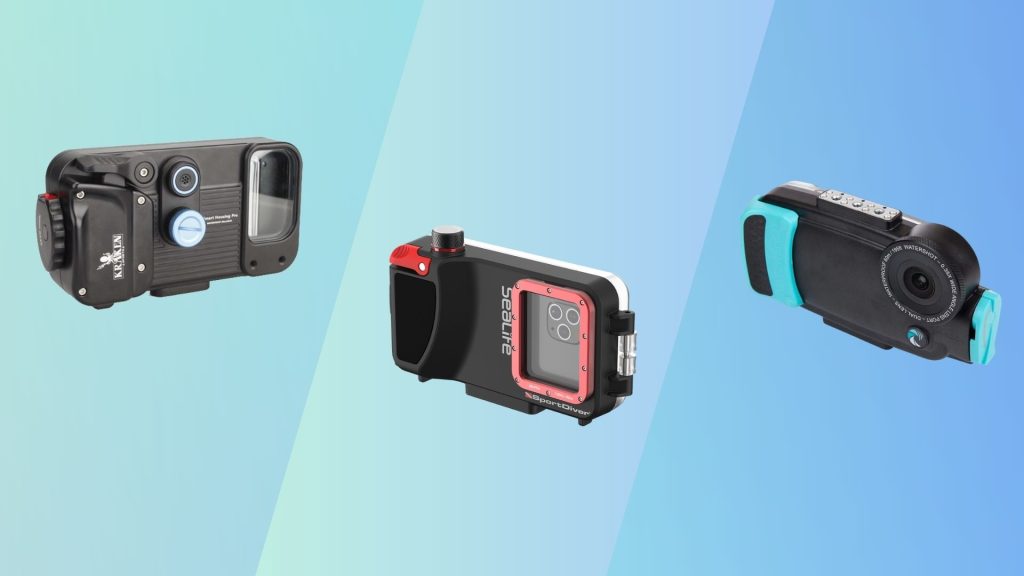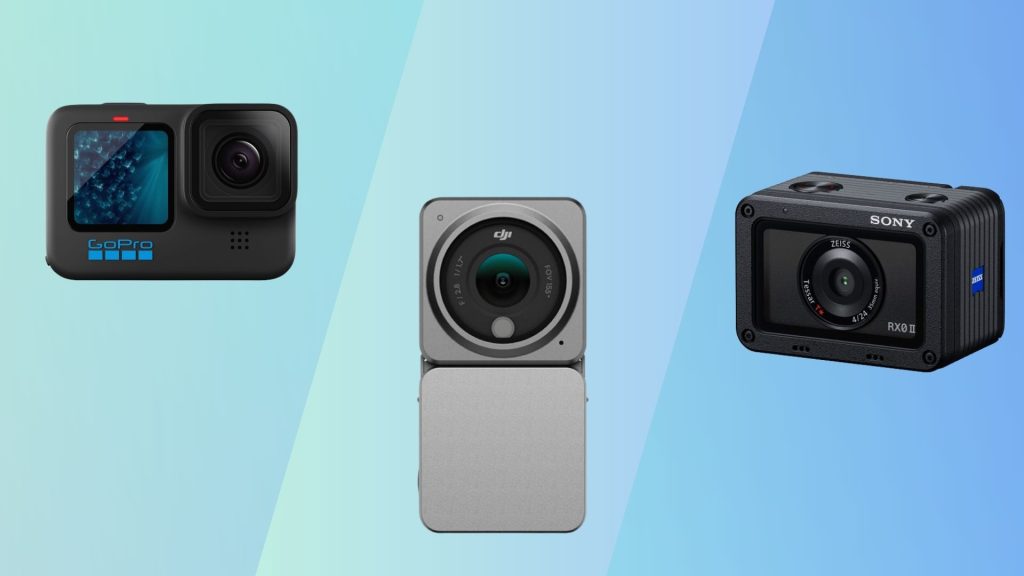Visit Rentovault to find adventure and photography
gear rentals from your neighbours.
Underwater photography can be a thrilling and rewarding experience for any beginner. It allows you to capture the beauty and diversity of the underwater world and share it with others. However, it requires the right gear to get the best shots. In this blog, we will look at three types of gear for underwater photography for beginners: phone housings for diving, action cameras such as GoPro, and diving housings for DSLR/mirrorless cameras.
Phone Housing for Diving
If you’re a beginner in underwater photography, using your phone is an excellent way to get started. Using a phone housing for diving has several advantages for beginner underwater photographers. Firstly, phone housings are relatively affordable compared to diving housings for DSLR/mirrorless cameras, making them an accessible option. They are also portable and easy to carry around, taking up minimal space in your diving bag.
Another benefit is the ease of use they offer. Most phone housings come with touch screen or button controls, allowing for easy operation of your phone’s camera underwater. This means you can spend more time focusing on capturing great photos and videos instead of struggling with complicated controls.
In addition, most modern smartphones have decent cameras that can capture excellent photos and videos, even underwater. This means that you don’t need to invest in an expensive camera to capture stunning underwater shots. Simply using your phone with a diving housing can produce great results.
Overall, using a phone housing for diving offers an affordable, portable, and easy-to-use option for capturing impressive underwater photos and videos.

Here are some popular diving housings for smartphones, along with their price ranges and depth ratings:
- SeaLife SportDiver – This housing is designed mainly for various iPhone models, supporting from iPhone 8 all the way to iPhone 14 Pro Max, but it also supports many Android models. The housing is rated for a depth of 40 meters (130 feet) and costs around 500 CAD.
- Kraken Sports KRH08 Universal Smart Phone Housing – The Kraken Sports housing is designed for any smartphones up to 83mm wide and 158mm tall. It is universal since it connects with the phone using a Smart Housing app available on both Apple App Store, and Google Play Store. It is rated for a depth of 80 meters (260 feet) and costs around 450 CAD.
- DIVEVOLK SeaTouch 4 MAX – The DIVEVOLK SeaTouch 4 MAX is a game-changer in underwater phone housing. Compatible with various iPhone models, it allows full touchscreen functionality underwater up to 60 meters. This housing not only protects your phone but also lets you use all apps and settings, making underwater photography a breeze. Retailing at 260 CAD, it’s an affordable and innovative solution for capturing your underwater adventures.
Action Cameras
Action cameras, such as the GoPro, are a popular choice for underwater photography and videography. They offer several advantages, but also have some drawbacks to consider.
One of the biggest advantages of using an action camera is their small size and portability. They can easily fit into a diving bag and won’t weigh you down while diving. They are also designed to be rugged and durable, making them ideal for underwater use.
Action cameras also offer a wide range of camera settings, including adjustable aperture, shutter speed, and ISO. This allows for more precise control over the camera settings, resulting in high-quality photos and videos.
Another advantage is the ability to shoot in high resolution, such as 4K or 5K video. This provides sharp and detailed footage of marine life and underwater scenery.
However, there are also some drawbacks to consider when using an action camera for underwater photography. The first is the cost, as high-end models can be expensive. Additionally, action cameras are designed for wide-angle shots, which can make it difficult to capture subjects that are farther away or smaller in size. Another limitation is the battery life, which can be relatively short. This means you may need to bring multiple batteries or have limited shooting time during a dive. Lastly, the small size of the camera can make it difficult to operate the controls while wearing diving gloves, and the LCD screen may be hard to see in bright sunlight.

Here are some of the most popular action cameras for diving along with their price ranges and depth ratings:
- GoPro HERO10/HERO11 Black: This is GoPro’s latest flagship camera and is designed for high-performance action and underwater photography. It has a depth rating of up to 10 meters (33 feet) without an additional housing and up to 60 meters (196 feet) with a protective housing. The price ranges from 450 to 500 CAD depending on the bundle.
- DJI Action 2: This is a popular alternative to the GoPro, offering similar features at a slightly lower price point. It has a depth rating of up to 10 meters (33 feet) without an additional housing and up to 60 meters (196 feet) with a specialized housing. The price ranges from 400 to 519 CAD depending on the bundle.
- Sony RX0 II: This camera is known for its high-quality imaging capabilities and compact design. It has a depth rating of up to 10 meters (33 feet) without an additional housing and up to 100 meters (328 feet) with an underwater housing. The price is about 899 CAD.
- Olympus TG-7: This is a popular choice for those looking for a rugged and waterproof camera. It has a depth rating of up to 15 meters (50 feet) without an additional housing and up to 45 meters (147 feet) with an underwater housing. The price ranges from 600 to 650 CAD depending on the bundle.
Diving Housings for DSLR/Mirrorless Cameras
If you’re serious about underwater photography, a DSLR or mirrorless camera is the way to go. They offer better image quality and control than a phone or action camera but also have some drawbacks to consider.
One of the biggest advantages of using a diving housing is the control it provides over the camera settings. DSLR and mirrorless cameras have a wider range of manual settings than most phone cameras or action cameras. This allows for more precise control over aperture, shutter speed, and ISO, which can result in high-quality underwater photos and videos.
Diving housings also offer a higher depth rating than phone housings or action cameras, with some models rated up to 100 meters (330 feet) or more. This makes them ideal for professional divers or underwater photographers who need to capture images at greater depths.
Another advantage is the ability to use a variety of lenses, allowing for more creative options and a wider range of shooting styles. This can result in unique and striking underwater images.
However, there are also some drawbacks to consider when using a diving housing for underwater photography. The first is the cost, as diving housings for high-end cameras can be very expensive. Additionally, they can be bulky and heavy, making them more difficult to transport and use underwater.
Another limitation is the learning curve associated with using a DSLR or mirrorless camera in a diving housing. These cameras require more technical knowledge and skill to use effectively, which can take time to master.
Lastly, the risk of water damage to your expensive camera gear is higher when using a diving housing, especially if the housing is not properly maintained or used. Careful handling and maintenance are required to ensure the housing remains watertight and your camera gear is protected.

There are several popular diving housings available for DSLR and mirrorless cameras, ranging in price and depth rating. Here are a few examples:
- Ikelite: Ikelite is a popular brand that offers a wide range of diving housings for DSLR and mirrorless cameras. Prices start at around $1,000 and can go up to $2,500 or more depending on the model. Depth ratings range from 60 meters (200 feet) to 100 meters (330 feet).
- Nauticam: Nauticam is another popular brand that offers high-quality diving housings for DSLR and mirrorless cameras. Prices start at around $1,500 and can go up to $5,000 or more depending on the model. Depth ratings range from 60 meters (200 feet) to 100 meters (330 feet).
- Sea&Sea: Sea&Sea is a Japanese brand that offers diving housings for several popular DSLR and mirrorless camera models. Prices start at around $1,500 and can go up to $3,500 or more depending on the model. Depth ratings range from 60 meters (200 feet) to 100 meters (330 feet).
- Aquatica: Aquatica is a Canadian brand that offers diving housings for several popular DSLR and mirrorless camera models. Prices start at around $2,000 and can go up to $4,500 or more depending on the model. Depth ratings range from 90 meters (300 feet) to 130 meters (425 feet).
Conclusion
In conclusion, choosing the right gear for underwater photography depends on your experience, budget, and the type of images you want to capture. Phone housings for diving are an affordable and easy-to-use option for beginners, while action cameras offer portability and durability for those who want to capture high-quality videos. For more serious underwater photographers, investing in a diving housing for a DSLR or mirrorless camera can provide better image quality and greater control over camera settings. No matter which option you choose, always remember to practice proper maintenance and care for your equipment to ensure its longevity and protect your investment.

